Meeting on The Aldenhaag Golden Fleece
May 2010
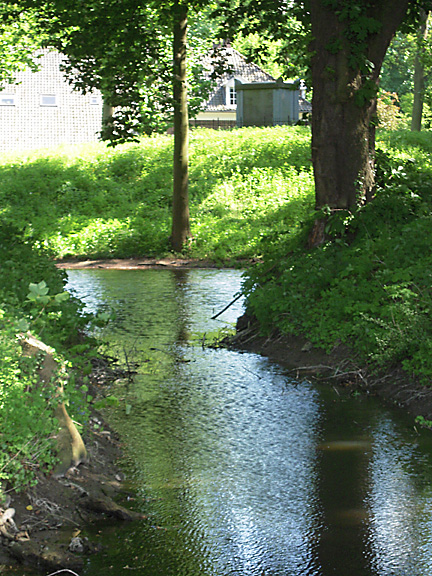
The motte at Aldenhaag with Baron Verstolk’s tomb as seen from the
entrance to the moat.
Behind the tomb is seen the Soelen House, near where the ancient Aldenhaag
manor house likely stood.
In May, 2010 a group of the scholars
working on the Aldenhaag Golden Fleece met in the Netherlands to examine the
sites associated with the Aldenhaag Fleece, and to discuss and evaluate all
evidence available at this time. A field visit was made of the sites associated
with the Aldenhaag Fleece, the known evidence was discussed and appraised and
work was begun on an article for scholarly publication. The discussions fell
into two areas: the location of the find, and thus its place of historic use,
and the original ownership and giving of the badge itself. After discussing
all the available facts and information we have seen, and visiting the sites,
it is the opinion of all the members of this study group that the Aldenhaag
Golden Fleece was indeed found c. 1970 somewhere on the ancient Aldenhaag motte
and bailey site. As the exact find spot was not remembered by the surviving
students who were then when it was found we can not be more specific.
THE PLACES — Aldenhaag
Aldenhaag, and Thedinghsweert as well, was one of a number of small castles
built just north of the Rhine River in the 13th century to protect the Netherlands.
These castles were mostly small towers defended by skillful use of the water
and muck that made up the land there, and although not likely to sustain a serious
military siege they offered both protection from bandits and raiders and a costly
delay to any invader. Below are two reconstructions made by the Netherlands
government of what the house and site likely looked like in the 13th century.
In the overall plan at left below the entrance drawbridge is from the west and
the castle on the east island.
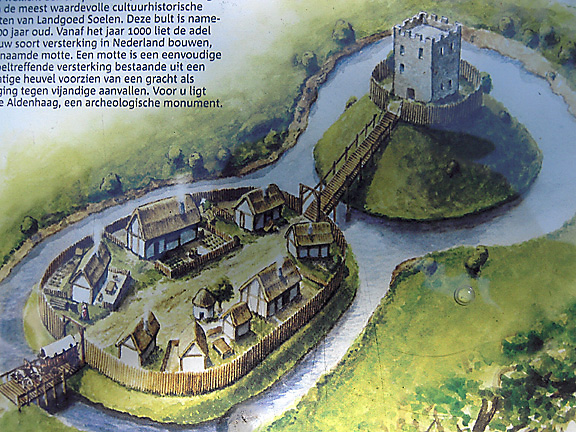
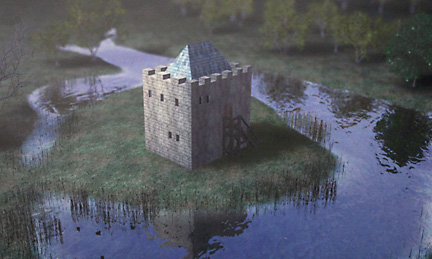
The then lord of Aldenhaag picked the wrong side in a regional dispute and
in punishment was ordered to demolish the castle himself around the year 1362.
Since that time there has been no evidence of another major structure on the
motte itself, although there were residences and farms nearby throughout. It
is possible that a shed, barn or storeroom was placed on the motte to take advantage
of its isolation and difficult access. Our walk there clearly showed how hard
it is to access the motte. Below are some photos of the site in 2010, and the
tangle of woods and swamp must be close to conditions when Willem van Duijn
and his fellow students explored the area around 1970. At left is the motte
and tomb from the north, and to its right the motte from the west. The current
well wooded and wild nature of Aldenhaag indicates that no structures have been
here for some time and that the removal of the original castle was thorough,
leaving no relics as of 2010.
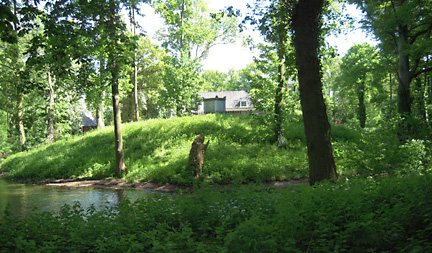
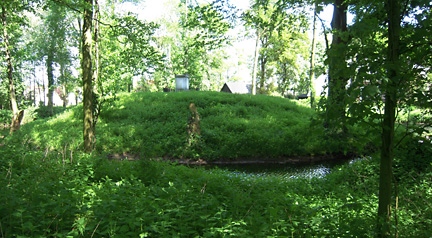
Below at left is how much scrambling we needed to do to access the site from
the west. In the middle is the north canal entrance to the moat with the motte
seen at the end of the canal. At the right is a close up of the Baron’s
tomb with the roof of the current modern house behind it. As there is no surviving
evidence for a manor house at any other place around the moat this is most likely
where the Renaissance house stood until 1574. Willem van Duijn’s friends
said that he was a souvenir collector, and that in addition to the golden fleece
he also acquired many other copper and bronze items that he kept in a box. His
friend Frank Hulsebosch, who was also on these walks, took away the handle to
the door to the Baron’s tomb as it was rusted and loose. At the time of
their visits to Aldenhaag it was possible to both reach the motte across the
moat and enter the tomb. Today the site is somewhat restored, the tomb is tight
and the motte protected by a cleaned out moat.
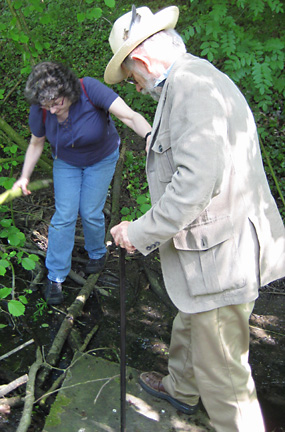
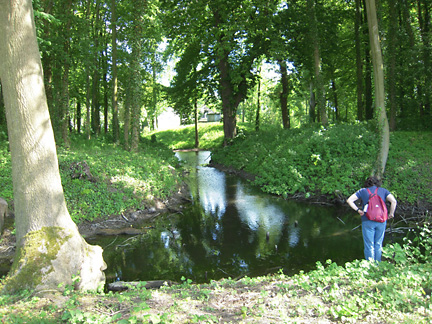
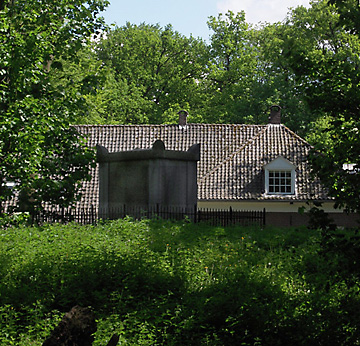
When we consider how short the distances are between towns and castles here,
about 1-3 miles, we see how easily, in 1574, those Calvinists escaped from Zoelen
to Buren which is just 10 miles away — about a three hour walk. Below
at left is a surviving windmill for grinding grain near Soelen/Aldenhaag on
the road to Buren, at right the statue of Anna of Buren, heiress to the van
Egmonds and these lands, her husband William of Orange and their two small children.
The son is the one later known as “Orange” who was kidnapped to
Spain by the Spanish forces but later returned to become both a member of the
Order of the Golden Fleece himself and a Calvinist. This is a seemingly impossible
combination, but one that also calls on us to be careful of absolute statements
about history. The statue in Buren does show the preservation of memories of
Anna van Buren and the rule of the Egmonds, as well as showing how the Egmonds
and William of Orange are seen as important figures in the creation myth of
the Netherlands as a nation. Even lesser members of this family such as Nicholas
Vijgh enjoyed the aura of this power and so were likely much more significant
figures in their time than their mere titles suggest.
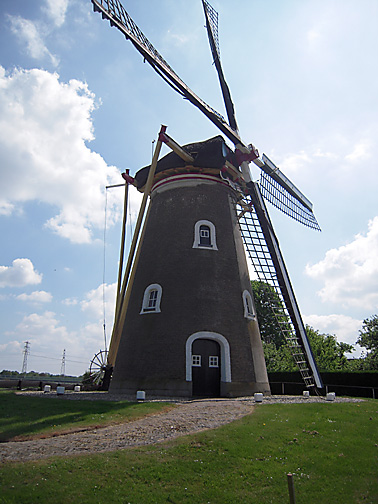
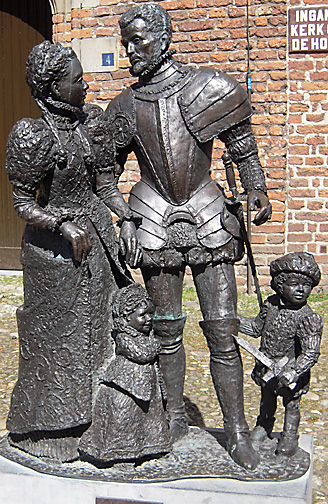
THE PLACES — Soelen
Only a few hundred yards south of Aldenhaag the surviving Soelen Castle shows
how Aldenhaag likely looked and would have been enlarged and modernized, if
it had survived. Soelen also is a motte and bailey multiple island castle and
is only a little more recent than Aldenhaag in its original construction. At
left below is the gatehouse where the Spanish crawled under the gate in 1574
to burn the house. To the right is Soelen Castle — a simple square tower
with added corner and center wings on a low motte inside a moat. It was interesting
to note the long walk from Soelen to Aldenhaag and how obscure the Aldenhaag
location would be if you wished to hide something securely. It is also of note
that Soelen has been continually improved and updated over the centuries and
it is home to several families today while Aldenhaag has sunk into near obscurity
and has only one home nearby, and that one is named for the Soelen castle.
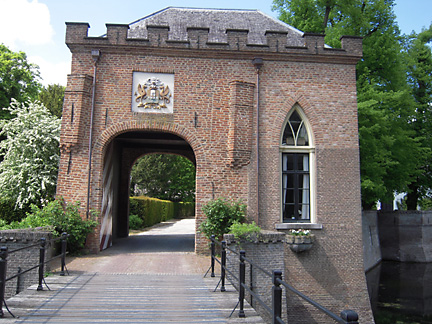
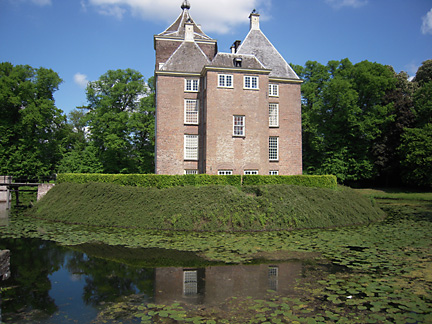
THE PLACES — Tiel
Nicolas Vijgh was amptman of Tiel, only some three miles from Aldenhaag. When
he married the illegitimate daughter of the Duke of Geldre he was, as part of
her dowry, given the fief of Aldenhaag that made him a minor noble, although
the family wealth and power was based on Tiel. Empty titles of nonexistent places
are rare at this date and there certainly was an Aldenhaag country home of some
sort there for Claus, reinforced by the Tiel Chronicle note that the
Spanish were looking for the Calvinists hiding at the house at Zoelen, or at
Aldenhaag. Tiel was bombarded and bombed to rubble when the Germans dug in there
in WW II, so little remains of early date. We are most lucky that the Tiel
Chronicle survived, or we would know little of Renaissance Tiel. Below are
photos of Vijgh’s amptsman house in Tiel and the coat of arms connected
with it. The house is rebuilt since 1945 but is of mostly original materials
and the walls survived at least in part. Note that the arms contain the imperial
eagle, indicating that this was an imperial city under charter and reflecting
both its long opposition to the protestants as a Habsburg city and its Spanish
garrison. Tiel was clearly the commercial town of note in this region, and it
is much more likely that a friend of the Habsburgs, who was also married to
a member of a prominent pro-Hapsburg family, and from a key town on the frontier
with the Dutch rebels would be appointed to the Golden Fleece than Claus’
title of amptman would first suggest. The historians who edited the Tiel
Chronicle for publication said that so far as they can determine the Tiel
Chronicle is accurate in details in every other case they can check, and
so it is very likely that the report of Claus Vijgh be a member of the Golden
Fleece is also accurate.
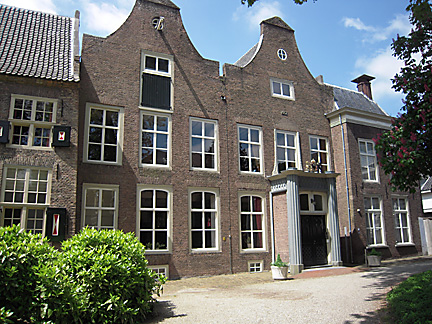

THE PLACES — Thedingsweert
Thedingsweert was in origin very similar in setting and size to Aldenhaag and
Soelen. The original castle, as mentioned earlier in this article, was destroyed
by drunken soldiers during the French Revolution and was replaced in the 19th
century by a modern manor house with created gardens. There is, we noted, no
record of any major artifacts being found when the manor house and water gardens
were being constructed in the 19th century, nor when the bio dynamic school
itself made extension excavations and design additions around 1970. However,
when Lode Bourez, a classmate of Willem van Duijn, made a survey of the arable
land around Thedingsweert around 1970 he collected numerous pottery shards from
the 16th to the 19th centuries that were most probably dumped there with refuse
from the nearby town of Tiel. This information, combined with the eye witness
reports by two of Willem van Duijn’s classmates that Aldenhaag was where
they walked and explored has convinced all of us that the Aldenhaag Fleece was
likely found at or near Aldenhaag c. 1970 and not at Thedingsweert. We also
agree that the finding of the fleece at Aldenhaag, in and of itself, does not
guarantee that the fleece belonged to someone at Aldenhaag in the 16th century
unless further information confirms the possibility. Below left is the manor
house today, and below right are Dr. Theo Broersen and Maryann Herold by the
water garden at Thedingsweert.
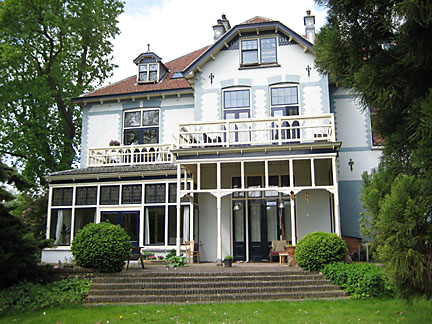
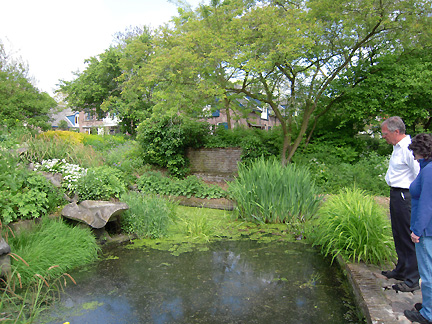
Just as an example of how rich the historical story is in the Netherlands I
show below a neolithic stone tomb near Assen where the Aldenhaag Fleece was
recently on display. We see Jan Jaap Hijh and Miekevan der Wal and Maryann Herold
checking out the interior. No matter where you go or how deep you dig there
seems to be records of the long past of human habitation in the Netherlands.
That the Aldenhaag Fleece should slowly erode out of some ruins after several
centuries is what one can expect.
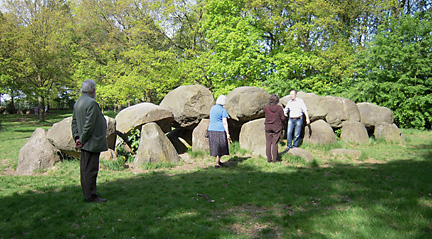
I. The Aldenhaag Fleece
II. The Hamlets of Thedinghsweert & Zoelen-Aldenhaag
III. The van Egmonds, Claes Vijgh & The Golden
Fleece
IV. The Standing Ram Fleece & Charles V
V. Documentation & Photos
VB. Documentation
& Photos II
Appendix 1. The Standing Ram Fleece As Seen in
the Insignie Orden Book & Other Catalogs
Appendix 2. Other Scholars Look At the Aldenhaag
Fleece
Appendix 3. Greek & Roman Mythology of the Golden
Fleece
3B. Classical Texts
That Mention the Golden Fleece
May 2010 Meeting on the Aldenhaag Fleece — 2.
The Fleece
Bibliography
Return to Society of the Golden Fleece
Return to the Golden Fleece Insignia Page
Antiques AtoZ Home Page
Medals, Orders
& Decorations
